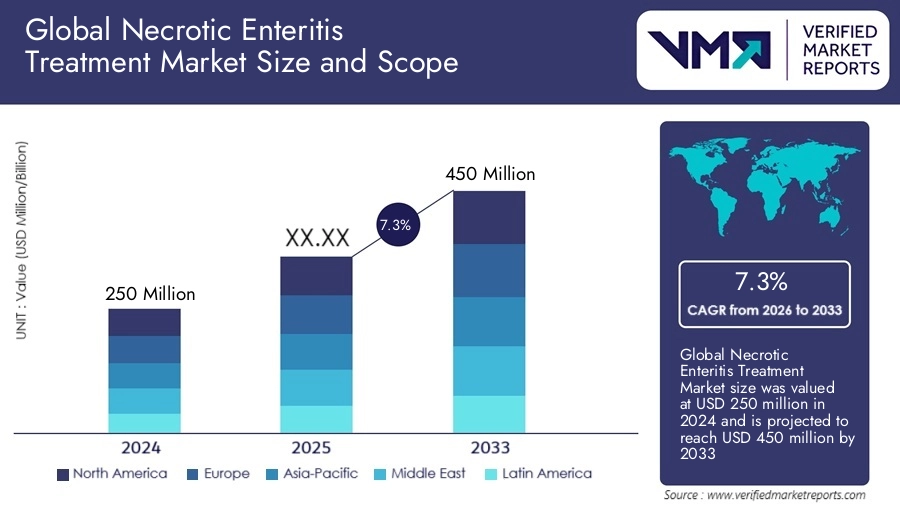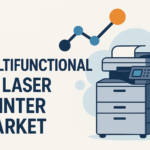Necrotic Enteritis Treatment Market Overview
Necrotic Enteritis (NE) is one of the most significant bacterial diseases affecting poultry worldwide, primarily caused by Clostridium perfringens. It results in intestinal lesions that lead to reduced weight gain, poor feed conversion, and in severe outbreaks, high mortality rates. The global economic losses attributed to NE are estimated at over USD 6 billion annually, driven by treatment costs, productivity losses, and the expenses related to prevention.
The Necrotic Enteritis Treatment Market currently sits at an approximate valuation of USD 1.3 billion as of 2024, with a steady compound annual growth rate (CAGR) projected at 6.5% through 2030. By 2030, the market is anticipated to cross USD 2.0 billion, driven by growing concerns about animal health, rising global poultry meat demand, and tightening regulations on antibiotic usage that are spurring innovation in alternative therapies.
Several factors fuel the expansion of this market. Firstly, global poultry consumption is climbing steadily due to population growth, urbanization, and a shift towards affordable protein sources. This directly raises the demand for effective disease management to protect flock productivity and food security. Secondly, the growing restriction or outright bans on antibiotic growth promoters (AGPs) in North America and Europe have forced poultry producers to look for alternative NE management solutions, such as probiotics, prebiotics, vaccines, and phytogenic feed additives.
Biotechnological advancements are playing a pivotal role in shaping this market’s landscape. Innovations in microbiome research, precision livestock farming, and genomic tools have paved the way for more targeted and effective interventions. Companies are investing heavily in developing next-generation vaccines and immunomodulators to provide more robust, long-term protection against C. perfringens.
Trends influencing the market include the surge in natural and organic feed additives, consumer-driven demand for antibiotic-free meat, and the push toward sustainable animal farming. Producers are under immense pressure to maintain animal health while meeting regulatory and consumer expectations for minimal antibiotic use. This dynamic environment has fostered strategic partnerships among feed additive manufacturers, biotech firms, and poultry integrators to develop integrated solutions.
Regionally, North America and Europe dominate the market due to well-established poultry industries and stringent regulatory frameworks restricting antibiotic use. However, the Asia-Pacific region is rapidly emerging as a key growth area. With its massive poultry population, rising incomes, and evolving regulatory landscape, countries like China, India, and Southeast Asian nations present lucrative opportunities for novel NE treatment solutions.
Overall, the Necrotic Enteritis Treatment Market is poised for a transformation. The shift from conventional antibiotic therapies to innovative, sustainable, and integrated disease management approaches is expected to redefine industry dynamics in the coming years.
Necrotic Enteritis Treatment Market Segmentation
The Necrotic Enteritis Treatment Market can be segmented into four primary categories: Treatment Type, Livestock Type, Mode of Administration, and Region. Each of these segments contains subsegments reflecting the diversity of treatment approaches and market demands.
1. Treatment Type
The Treatment Type segment is pivotal in defining how the market addresses the control and prevention of Necrotic Enteritis in poultry. Traditionally, antibiotics were the frontline treatment, but due to the mounting threat of antimicrobial resistance and stricter regulations, producers are diversifying towards alternative solutions. The subsegments under Treatment Type include Antibiotics, Vaccines, Probiotics & Feed Additives, and Phytogenics & Enzymes.
Antibiotics remain prevalent in some regions, particularly in countries where regulatory frameworks are less stringent. They are effective for therapeutic intervention during outbreaks but face declining market share due to public health concerns. Vaccines are an area of rapid innovation, with research focusing on recombinant and inactivated vaccines that stimulate robust immunity against C. perfringens. Probiotics & Feed Additives have gained significant traction as preventive solutions that enhance gut health, modulate microbiota, and improve bird resilience naturally. Lastly, Phytogenics & Enzymes include herbal extracts, essential oils, and enzyme-based products that inhibit bacterial growth and boost nutrient digestibility, providing a holistic alternative to traditional treatments. As producers pivot towards sustainable solutions, these subsegments are projected to grow strongly, redefining treatment protocols globally.
2. Livestock Type
The Livestock Type segment categorizes the market based on the poultry varieties affected by Necrotic Enteritis. The subsegments include Broilers, Layers, Turkeys, and Other Poultry.
Broilers form the largest subsegment, representing over 70% of market demand. The broiler industry’s rapid growth, short production cycles, and high stocking densities make broilers highly susceptible to NE outbreaks, driving demand for effective treatment and prevention strategies. Layers, though less vulnerable than broilers, still present significant market potential, especially for treatments aimed at prolonging flock health and egg production efficiency. Turkeys are another important subsegment, with the turkey meat industry particularly strong in North America and parts of Europe. Turkeys are highly prone to NE, especially during certain production phases. Other Poultry, which includes ducks, quail, and geese, is a smaller but growing subsegment as diversified poultry farming expands worldwide. Each poultry type presents unique disease management challenges, requiring tailored solutions to optimize productivity and minimize economic losses.


